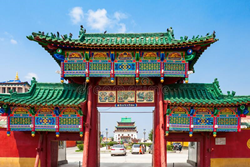

13th June 2022 (6 Topics)
Context
Four Holy Relics of Lord Buddha are being taken to Mongolia for an 11-day exposition to coincide with Mongolian Budhha Purnima celebrations.
About
- Four holy relics of Lord Buddha also known as “Kapilvastu relics” have been flown from India to Mongolia for display for 11 days at the Batsagaan temple in Gandan Monastery of Ulaanbataar exposition.
- It would be part of celebrations of the neighbouring country’s Buddha Purnima falling on June 14.
- The four relics come from among 22 Buddha relics, currently housed at Delhi’s National Museum.
- The site was discovered in 1898.

Gandan Monastery
Relics of Buddha:
- The Buddha is said to have died between 486-483 B.C., according to traditional accounts, at the age of eighty in Kushinagar.
- The Mallas of Kushinagar cremated his body with ceremonies befitting a universal king.
- His relics from the funeral pyre were collected and divided into eight shares to be distributed among
- the Ajathsatrus of Magadha,
- the Licchavis of Vaishali,
- the Sakyas of Kapilavastu,
- Mallas of Kushinagar,
- Bullies of Allakappa,
- the Mallas of Pava,
- the Koliyas of Ramagrama and
- a Brahmana of Vethadipa.
- The purpose was erecting stupas over the sacred relics.
- Two more stupas came up, one over the urn in which the relics had been collected and the other over the embers.
- The relics were later dug up by Ashoka — the Maurya Dynasty emperor, who ruled almost the entire Indian subcontinent from c. 268 to 232 B.C.
- He distributed the relics and had stupas built over them throughout the region he ruled.
- Many of the remains ended up in places that are other countries today.
- According to The Ashokavadana, Ashoka had Buddha's relics placed in 84,000 stupas built by Yakshas (usually benevolent nature-spirits).

About Safety:
- In 2015, the Holy Relics were placed under the ‘AA’ category of Antiquities and Art Treasures which should not be ordinarily taken out of the country for exhibition, considering their delicate nature.
|
What are antiquities?
|
More Articles


